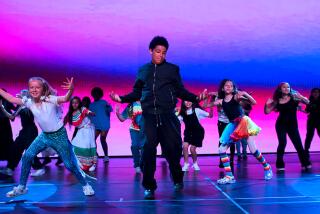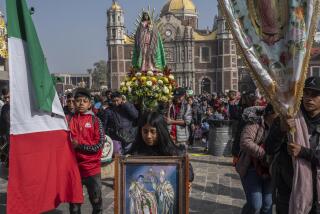Church Brings Dance to Christmas Carols
GRANADA HILLS — A Presbyterian church is inviting all comers to dance to Christmas carols Sunday. Not merely sing them, but dance to them, in a sort of Yuletide line dance.
Jeannine Bunyan of North Hills will teach young and old at Granada Hills First Presbyterian Church some simple movements to go with carols such as “Deck the Halls,” “Joy to the World” and “We Three Kings.”
Carol dancing has roots in Medieval times when dancing during the chorus was possible in churches, which in those days had no pews. The Christmas carol dance at 2 p.m. Sunday will be in the church’s fellowship hall.
Bunyan has been encouraging churches in the San Fernando Valley since 1983 to use dance whenever appropriate in religious expression. She is now the Southern California representative of the Sacred Dance Guild, a nationwide group of 800 dance leaders, clergy and church music directors.
Her lay ministry is a far cry from an earlier performance: dancing in the orgiastic scene around the golden calf idol in Cecil B. DeMille’s 1956 remake of “The Ten Commandments.”
As a young woman she toured with the Chicago Civic Opera Ballet before coming to Southern California and landing dancing roles in several films in the mid-1950s, including “Meet Me in Las Vegas” with Cyd Charisse, “Anything Goes” with Bing Crosby and Donald O’Connor, and “You’re Never Too Young” with Dean Martin and Jerry Lewis. Bunyan was also in a ballroom dancing scene in “Marty,” starring Ernest Borgnine.
Bunyan says she calls her volunteer work in churches a “movement ministry” instead of dancing because of the still-common discomfort of many Christians with dancing on church grounds.
This, despite the fact that liturgical dance has gained footholds in some Catholic circles in recent decades, and some Protestant churches have lately attempted to overcome a longtime cultural taboo against social dancing.
“The word ‘movement’ is less threatening for people,” she said. “I want people to have the opportunity to experience through movement and dance that which the intellect cannot experience.”
Proponents of religious dance note that the Book of Psalms (150:4) urges praise of God through sounds of various musical instruments, including “tambourine and dance.”
They often cite the work of Doug Adams, who teaches at the Pacific School of Religion in Berkeley and edited “Dancing Christmas Carols,” which has gone through four editions since it was first published in 1978.
When dancing was permissible in Medieval churches, the worshipers would dance during a song’s chorus, a word that means dance or a line of dancers, and they would stop during the song’s stanza, which means stand or halt, Adams said.
“I think we can say that folk forms of dance were common in churches until the 14th century,” Adams said in an interview. “As hierarchies grew more developed in the church, dance became a concern because it tended to put everyone on equal footing--laypeople, priests and bishops.”
Bunyan has previously held either workshops or Christmas carol dance events not only at the Granada Hills church but also at the Sepulveda and Reseda United Methodist churches and Prince of Peace Episcopal Church in Woodland Hills.
For her modern blend of dance movements to Christmas carols, Bunyan said that she has choreographed some basic group movements that convey religious symbolism corresponding to the words of the holiday favorites.
The Christmas dance party at Granada Hills First Presbyterian will begin with “Oh, Come All Ye Faithful,” she said. Processional movements from four corners of the church hall will converge on the middle of the building, she said.
“Processionals stress the majesty and direction of our spiritual path toward God,” Bunyan said. “The movement within a circle, such as during ‘Joy to the World,’ emphasizes God’s presence among us.”
A third basic movement she will teach is called the tripudium, deriving from the Middle Ages. “Two steps forward and one back--forward to God, but acknowledging setbacks,” Bunyan said.
“Hope is always in our forward spiritual journey, and that’s the step we will use in ‘We Three Kings.’ ”
More to Read
The biggest entertainment stories
Get our big stories about Hollywood, film, television, music, arts, culture and more right in your inbox as soon as they publish.
You may occasionally receive promotional content from the Los Angeles Times.










